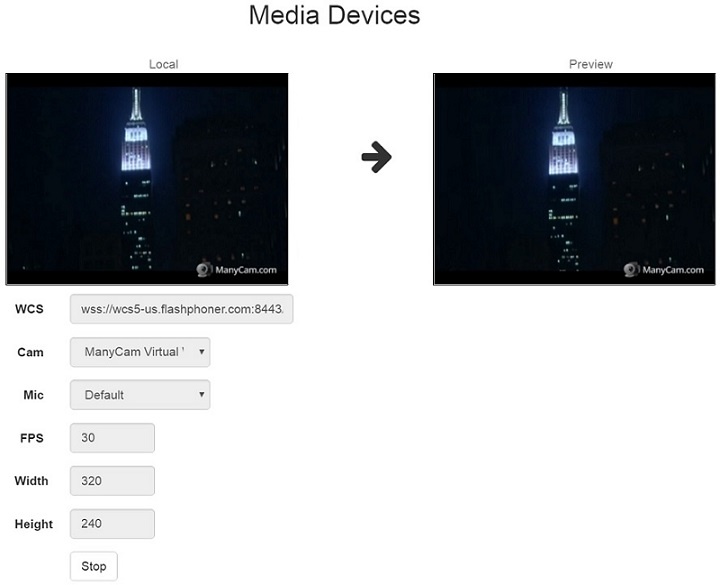Example of streamer with access to media devices
This streamer can be used to publish the following types of streams on Web Call Server
- WebRTC
- RTMFP
- RTMP
and allows to select media devices and parameters for the published video
- camera
- microphone
- FPS (Frames Per Second)
- resolution (width, height)
On the screenshot below a stream is being published from the client.
Two videos are played on the page
- 'Local' - video from the camera
- 'Preview' - the video as received from the server
Code of the example
The path to the source code of the example on WCS server is:
/usr/local/FlashphonerWebCallServer/client/examples/demo/streaming/media_devices_manager
manager.css - file with styles
media_device_manager.html - page of the streamer
manager.js - script providing functionality for the streamer
This example can be tested using the following address:
https://host:8888/client/examples/demo/streaming/media_devices_manager/media_device_manager.html
Here host is the address of the WCS server.
Work with code of the streamer
To analyze the code, let's take the version of file manager.js, which is available here and can be downloaded with corresponding build 0.5.28.2747.
1. Initialization of the API.
Flashphoner.init() code
Flashphoner.init({
flashMediaProviderSwfLocation: '../../../../media-provider.swf',
mediaProvidersReadyCallback: function (mediaProviders) {
//hide remote video if current media provider is Flash
if (mediaProviders[0] == "Flash") {
$("#fecForm").hide();
$("#stereoForm").hide();
$("#sendAudioBitrateForm").hide();
$("#cpuOveruseDetectionForm").hide();
}
if (Flashphoner.isUsingTemasys()) {
$("#audioInputForm").hide();
$("#videoInputForm").hide();
}
}
})
2. List available media devices.
Flashphoner.getMediaDevices() код
When media devices are listed, drop-down lists on client page are filled.
Flashphoner.getMediaDevices(null, true).then(function (list) {
list.audio.forEach(function (device) {
...
});
list.video.forEach(function (device) {
...
});
...
}).catch(function (error) {
$("#notifyFlash").text("Failed to get media devices");
});
3. Get audio and video publishing constraints from client page
getConstraints() code
Publishing sources:
- camera (sendVideo)
- microphone (sendAudio)
- HTML5 Canvas (sendCanvasStream)
constraints = {
audio: $("#sendAudio").is(':checked'),
video: $("#sendVideo").is(':checked'),
customStream: $("#sendCanvasStream").is(':checked')
};
Audio constraints:
- microphone choise (deviceId)
- error correction for Opus codec (fec)
- stereo mode (stereo)
- audio bitrate (bitrate)
if (constraints.audio) {
constraints.audio = {
deviceId: $('#audioInput').val()
};
if ($("#fec").is(':checked'))
constraints.audio.fec = $("#fec").is(':checked');
if ($("#sendStereoAudio").is(':checked'))
constraints.audio.stereo = $("#sendStereoAudio").is(':checked');
if (parseInt($('#sendAudioBitrate').val()) > 0)
constraints.audio.bitrate = parseInt($('#sendAudioBitrate').val());
}
Video constraints:
- camera choise (deviceId)
- publishing video size (width, height)
- minimal and maximal video bitrate (minBitrate, maxBitrate)
- FPS (frameRate)
constraints.video = {
deviceId: {exact: $('#videoInput').val()},
width: parseInt($('#sendWidth').val()),
height: parseInt($('#sendHeight').val())
};
if (Browser.isSafariWebRTC() && Browser.isiOS() && Flashphoner.getMediaProviders()[0] === "WebRTC") {
constraints.video.width = {min: parseInt($('#sendWidth').val()), max: 640};
constraints.video.height = {min: parseInt($('#sendHeight').val()), max: 480};
}
if (parseInt($('#sendVideoMinBitrate').val()) > 0)
constraints.video.minBitrate = parseInt($('#sendVideoMinBitrate').val());
if (parseInt($('#sendVideoMaxBitrate').val()) > 0)
constraints.video.maxBitrate = parseInt($('#sendVideoMaxBitrate').val());
if (parseInt($('#fps').val()) > 0)
constraints.video.frameRate = parseInt($('#fps').val());
4. Get access to media devices for local test
Flashphoner.getMediaAccess() code
Audio and video constraints and <div>-element to display captured video are passed to the method.
Flashphoner.getMediaAccess(getConstraints(), localVideo).then(function (disp) {
$("#testBtn").text("Release").off('click').click(function () {
$(this).prop('disabled', true);
stopTest();
}).prop('disabled', false);
...
testStarted = true;
}).catch(function (error) {
$("#testBtn").prop('disabled', false);
testStarted = false;
});
5. Connecting to the server
Flashphoner.createSession() code
Flashphoner.createSession({urlServer: url}).on(SESSION_STATUS.ESTABLISHED, function (session) {
//session connected, start streaming
startStreaming(session);
}).on(SESSION_STATUS.DISCONNECTED, function () {
setStatus(SESSION_STATUS.DISCONNECTED);
onStopped();
}).on(SESSION_STATUS.FAILED, function () {
setStatus(SESSION_STATUS.FAILED);
onStopped();
});
6. Receiving the event confirming successful connection
ConnectionStatusEvent ESTABLISHED code
Flashphoner.createSession({urlServer: url}).on(SESSION_STATUS.ESTABLISHED, function (session) {
//session connected, start streaming
startStreaming(session);
}).on(SESSION_STATUS.DISCONNECTED, function () {
...
}).on(SESSION_STATUS.FAILED, function () {
...
});
7. Stream publishing
session.createStream(), publishStream.publish() code
publishStream = session.createStream({
name: streamName,
display: localVideo,
cacheLocalResources: true,
constraints: constraints,
mediaConnectionConstraints: mediaConnectionConstraints
...
});
publishStream.publish();
8. Receiving the event confirming successful streaming
StreamStatusEvent PUBLISHING code
On receiving the event, the preview stream is created with session.createStream() method and play() is called to play it
publishStream = session.createStream({
name: streamName,
display: localVideo,
cacheLocalResources: true,
constraints: constraints,
mediaConnectionConstraints: mediaConnectionConstraints
}).on(STREAM_STATUS.PUBLISHING, function (publishStream) {
$("#testBtn").prop('disabled', true);
var video = document.getElementById(publishStream.id());
//resize local if resolution is available
if (video.videoWidth > 0 && video.videoHeight > 0) {
resizeLocalVideo({target: video});
}
enableMuteToggles(true);
if ($("#muteVideoToggle").is(":checked")) {
muteVideo();
}
if ($("#muteAudioToggle").is(":checked")) {
muteAudio();
}
//remove resize listener in case this video was cached earlier
video.removeEventListener('resize', resizeLocalVideo);
video.addEventListener('resize', resizeLocalVideo);
setStatus(STREAM_STATUS.PUBLISHING);
//play preview
var constraints = {
audio: $("#playAudio").is(':checked'),
video: $("#playVideo").is(':checked')
};
if (constraints.video) {
constraints.video = {
width: (!$("#receiveDefaultSize").is(":checked")) ? parseInt($('#receiveWidth').val()) : 0,
height: (!$("#receiveDefaultSize").is(":checked")) ? parseInt($('#receiveHeight').val()) : 0,
bitrate: (!$("#receiveDefaultBitrate").is(":checked")) ? $("#receiveBitrate").val() : 0,
quality: (!$("#receiveDefaultQuality").is(":checked")) ? $('#quality').val() : 0
};
}
previewStream = session.createStream({
name: streamName,
display: remoteVideo,
constraints: constraints
...
});
previewStream.play();
}).on(STREAM_STATUS.UNPUBLISHED, function () {
...
}).on(STREAM_STATUS.FAILED, function () {
...
});
publishStream.publish();
9. Preview stream playback stop
previewStream.stop() code
$("#publishBtn").text("Stop").off('click').click(function () {
$(this).prop('disabled', true);
previewStream.stop();
}).prop('disabled', false);
10. Receiving the event confirming successful playback stop
StreamStatusEvent STOPPED code
previewStream = session.createStream({
name: streamName,
display: remoteVideo,
constraints: constraints
}).on(STREAM_STATUS.PLAYING, function (previewStream) {
...
}).on(STREAM_STATUS.STOPPED, function () {
publishStream.stop();
}).on(STREAM_STATUS.FAILED, function () {
...
});
previewStream.play();
11. Streaming stop after preview playback stopped
publishStream.stop() code
previewStream = session.createStream({
name: streamName,
display: remoteVideo,
constraints: constraints
}).on(STREAM_STATUS.PLAYING, function (previewStream) {
...
}).on(STREAM_STATUS.STOPPED, function () {
publishStream.stop();
}).on(STREAM_STATUS.FAILED, function () {
...
});
previewStream.play();
12. Receiving the event confirming successful streaming stop
StreamStatusEvent UNPUBLISHED код
publishStream = session.createStream({
name: streamName,
display: localVideo,
cacheLocalResources: true,
constraints: constraints,
mediaConnectionConstraints: mediaConnectionConstraints
}).on(STREAM_STATUS.PUBLISHING, function (publishStream) {
...
}).on(STREAM_STATUS.UNPUBLISHED, function () {
setStatus(STREAM_STATUS.UNPUBLISHED);
//enable start button
onStopped();
}).on(STREAM_STATUS.FAILED, function () {
...
});
publishStream.publish();
